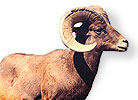Bighorn Sheep
Bighorn Sheep (Ovis canadensis) is one of three species of mountain sheep in North America and Siberia; the other two species being Ovis dalli, that includes Dall Sheep and Stone's Sheep, and the Siberian Snow sheep Ovis nivicola.The taxononomy continues to be modified as new genetic and morphologic data becomes available but most scientists currently recognize the following subspecies of bighorn:Rocky Mountain Bighorn Sheep (Ovis canadensis canadensis) Sierra Nevada Bighorn Sheep (Ovis canadensis sierrae), formerly California Bighorn Sheep, Desert Bighorn Sheep (Ovis canadensis nelsoni) In addition, there are currently two federally endangered populations:Sierra Nevada Bighorn Sheep (Ovis canadensis sierrae), recognized as a unique subspecies Peninsular Bighorn Sheep, a distinct population segment of Desert Bighorn Sheep (Ovis canadensis nelsoni) Big Horn Sheep Buy at AllPosters.comFramed MountedWild sheep crossed the Bering land bridge from Siberia during the Pleistocene (~750,000 years ago) and, subsequently, spread through western North America as far south as Baja California and northern mainland Mexico. Divergence from their closest Asian ancestor (Snow sheep) occurred about 600,000 years ago. In North America, wild sheep have diverged into two extant species — Dall sheep that occupy Alaska and northwestern Canada, and bighorn sheep that range from southern Canada to Mexico. However, the status of these species is questionable given that hybridization has occurred between them in their recent evolutionary history.Two hundred years ago, Bighorn Sheep were widespread throughout the western United States, Canada, and Northern Mexico. Some estimates placed their population at higher than 2 million. However, by around 1900, hunting, competition from domesticated sheep, and diseases had decreased the population to only several thousand. A program of reintroductions, natural parks, and reduced hunting, together with a decrease in domesticated sheep near the end of World War II, allowed the Bighorn Sheep to make a comeback, though not before Ovis canadensis auduboni, a sub-species that lived on the Black Hills, went extinct.Bighorn sheep were amongst the most admired animals of the Apsaalooka, or Crow, people, and what is today called the Bighorn Mountain Range was central to the Apsaalooka tribal lands. Bighorn Sheep are hunted for their meat and horns, which are used in ceremonies, as food, and as hunting trophies. They also serve as a source of eco-tourism, as tourists come to see the famed Bighorn Sheep in their native habitat. Bighorn Sheep are considered good indicators of land health because the species is sensitive to many human-induced environmental problems. In addition to their aesthetic value, Bighorn Sheep are considered desirable game animals by hunters. The Rocky Mountain and Sierra Nevada bighorn occupy the cooler mountainous regions of Canada and the United States. In contrast, the Desert Bighorn Sheep subspecies are indigenous to the hot desert ecosystems of the Southwest United States.The latest science shows that Bighorn Sheep is one species, with 3 subspecies O. c. canadensis, O. c. nelsoni and O. c. sierrae. O. c. sierrae is a genetically distinct subspecies that only occurs in the Sierra Nevada. O. c. nelsoni occur throughout the southwestern desert regions of the U.S. and Mexico, whereas O. c. canadensis occupy the U.S. and Canadian Rocky Mountains and the northwestern U.S.
Article Index:
Big Horn Sheep Watching…KEYWORDS: where to see bighorn sheep in California big horn sheep watching Anza-Borrego Desert State Park california state park animals Peninsular Bighorn Sheep state park near San Diego
AUTHOR: Ranger Jeri Zemon
In 1933, Anza-Borrego was set aside as a state park, in part to preserve the habitat of the Peninsular Bighorn Sheep. Since then, their numbers have decreased, and spotting a Bighorn has become a rare experience in California. We are fortunate that it is still possible to see a Bighorn Sheep in the wild during a visit to Anza-Borrego Desert State Park.
Big Horn Sheep Fact Sheet…All about the Desert Bighorn Sheep, its scientific names, common names, description, behavior, range, habitats and life cycle….KEYWORDS: rocky mountain big horn sheep artiodactyla bovidae caprinae ovis canadensis Ovis canadensis nelsoni endangered species desert subspecies
 Class: Mammalia
Class: Mammalia
Order: Artiodactyla
Family: Bovidae
Sub Family: Caprinae
Genus: Ovis
Species: canadensis
Bighorn Geography – Range
The natural range of Ovis canadensis was formerly in the Rocky Mountains from southern Canada to Colorado, but is now reduced to small bands protected by inaccessible habitat or by refuges. The desert subspecies (Ovis canadensis nelsoni) ranges from Nevada and California to west Texas and south into Mexico. Another rare member inhabits the Sierra Nevada Mountain of California.
Last Rites for a Desert Bighorn…KEYWORDS: desert bighorn sheep big horn sheep coyote
AUTHOR: Ranger Jim Meier
It was most unusual to see Mama Ewe standing in the same spot where I’d last seen her. But there she was, in the clearing at Lower Willows in Coyote Canyon where I’d seen her two days before during the bighorn sheep count. Four legs spread wide; her head hung as if muscles were not attached. Drainage flowed from her eyes and nose. Something must be done!
